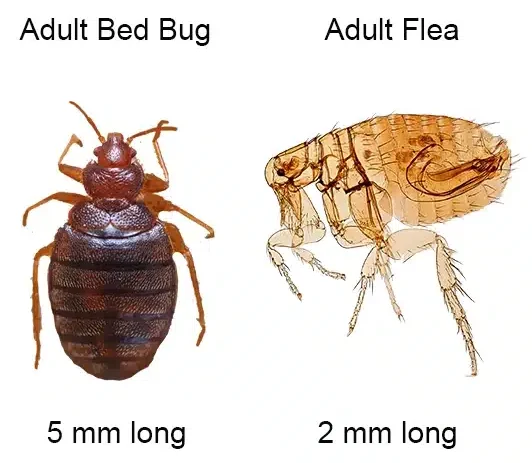
Fleas and bed bugs are completely different creatures. However, while they may differ in appearance, you may be unable to distinguish them. One of the similarities that many people get confused about is the bite marks that these critters can leave.
In this article, we will help you distinguish between their bite marks and how they can be treated.
Flea Bites vs Bed Bug Bites
The first and most obvious difference between flea bites and bed bug bites is the location of the bite. Flea bites typically occur on the lower body, such as the ankles, legs, and waist, while bed bug bites will appear on any exposed body area, including the face, neck, arms, and hands. Flea bites are usually small and red, while bed bug bites are larger and inflamed.
The symptoms of flea bites and bed bug bites can also vary. Flea bites can cause itching, irritation, and swelling, while bed bug bites can cause itching, swelling, redness, and sometimes hives. In addition, flea bites can cause an allergic reaction, including hives, rash, and fever. On the other hand, bed bug bites typically do not cause an allergic reaction.
How to Treat Flea Bites
Once the flea bites have been identified, a few steps can be taken to reduce itching and inflammation. Applying a cold compress or an anti-itch cream can help to soothe the bites and reduce inflammation. If the bites are particularly itchy, an over-the-counter antihistamine may help reduce symptoms.
It is also important to take steps to prevent future flea infestations. Vacuuming and washing bedding and upholstery regularly can help to reduce flea populations. Additionally, treating pets with flea and tick preventatives can help to reduce the risk of fleas in the home.
How to Treat Bed Bug Bites
Once you have identified the bed bug bites, clean the area with soap and water. This will help to reduce the itching and irritation. After cleaning the area, apply an over-the-counter hydrocortisone cream to the affected area. This will help to reduce inflammation and itching.
Consider taking an antihistamine, such as Benadryl, to help reduce the itching and discomfort caused by the bites. Additionally, you can use a cold compress or an ice pack to help reduce the swelling.
Keeping Your Home Clean from Fleas and Bed Bugs
The first step in preventing an infestation of fleas or bed bugs is to keep your home clean. Vacuum carpets and rugs often, especially if you have pets. Vacuuming can help remove flea eggs and bed bug eggs from carpets and rugs. Make sure to dispose of the vacuum bag after each use. Wash bedding and curtains in hot water, and dry them on high heat. This will help kill any existing fleas or bed bugs.
Of course, cleaning alone won’t get rid of fleas and bed bugs. You have to use products that effectively repel and kill these bugs, like our solutions at Bed Bug Barrier.

It is also important to regularly inspect your home for signs of fleas or bed bugs. Look for small, dark spots on mattresses, furniture, and carpets. These spots may be flea or bed bug droppings. You may also see live fleas or bed bugs on furniture and carpets. If you find any signs of fleas or bed bugs, it is important to call a professional pest control company.
Finally, sealing any cracks or crevices in the home is important. This will help keep fleas and bed bugs from entering your home. Make sure to seal off any cracks or crevices around windows and doors. This will also help keep other pests out of the home.
Conclusion
Many types of pests can infest your home, but fleas and bed bugs are two of the most common. Both pests can cause many problems for homeowners, so it’s important to be aware of them and know how to prevent them.
If you are looking for bed bug treatment, you can try our bed bug products at Bed Bug Barrier. Our products do not use any chemicals, making sure that you stay safe and healthy. Try out our treatments at Bed Bug Barrier.
Are You Looking for an Organic DIY Solution?
Watch Our DIY Treatment Video For An Ensemble Bed
Watch Our DIY Treatment Video For A Bed with Slats



Leave a Reply